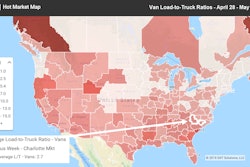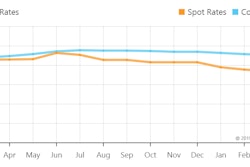It’s typical for spot truckload freight volumes to get a bounce during the week after a holiday. Sure enough, the number of posted loads increased 1% during the week ending April 28, said DAT Solutions, which operates the DAT network of load boards.
While the number of available trucks fell 4%, there still was enough capacity to meet demand and national average spot rates ended the last full week of April at or below their averages for the month of March.
National average spot rates through April 28
*Van: $1.81/mile, 4 cents lower than the March average
*Refrigerated: $2.15/mile, 2 cents lower
*Flatbed: $2.34/mile, unchanged
Trend to watch: Big-market van volume
Average spot rates increased on just 37 of the top 100 van lanes last week. The good news is that volumes — loads actually moved — are higher than they’ve been at this time in the past three years. The national van load-to-truck ratio was 1.6, and five of the top six van markets had higher freight volumes.
Markets to watch: Florida and South Georgia
From Miami to Savannah, reefer load-to-truck ratios were elevated into the weekend last week. When business spills over into Saturday, that’s a good sign for truckers. Miami’s ratio went from 8.8 on Friday, April 26, to 19.7 the next day. Lakeland increased from 5.4 to 19.5. The ratio in Savannah jumped from 9.1 to 16.5.

That’s a lot of freight for a Saturday: there were 1,382 loads posted in Miami and 1,191 loads in Lakeland. Harvests of sweet corn, melons, mixed vegetables, and potatoes are under way, according to the USDA.
 The location of major cherry producers in California, where farmers expect a record harvest this year. Source: California Cherries
The location of major cherry producers in California, where farmers expect a record harvest this year. Source: California CherriesBonus market: Cherries from Central California
California’s cherry farmers are dotted throughout central California from near Bakersfield up to Sacramento and Stockton. The good news is that growers expect to ship a record number of cases in 2019 — more than 10 million versus just shy of 4 million cases last year. If each case weighs 16 to 18 pounds, we’re talking about 4,000 truckloads for this commodity in 2019.
Most of those cases need to move between now and the middle of June. So put that on top of your sundae.









